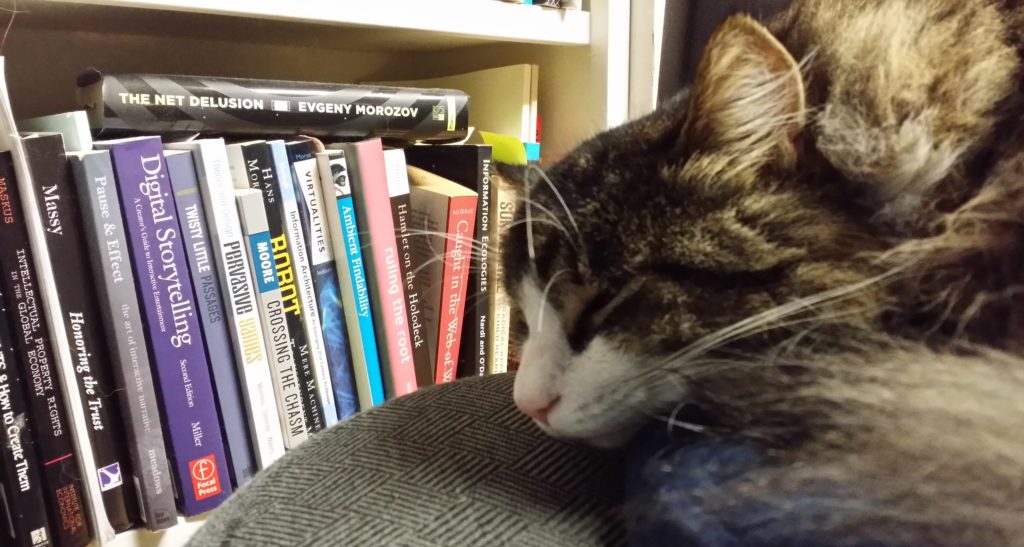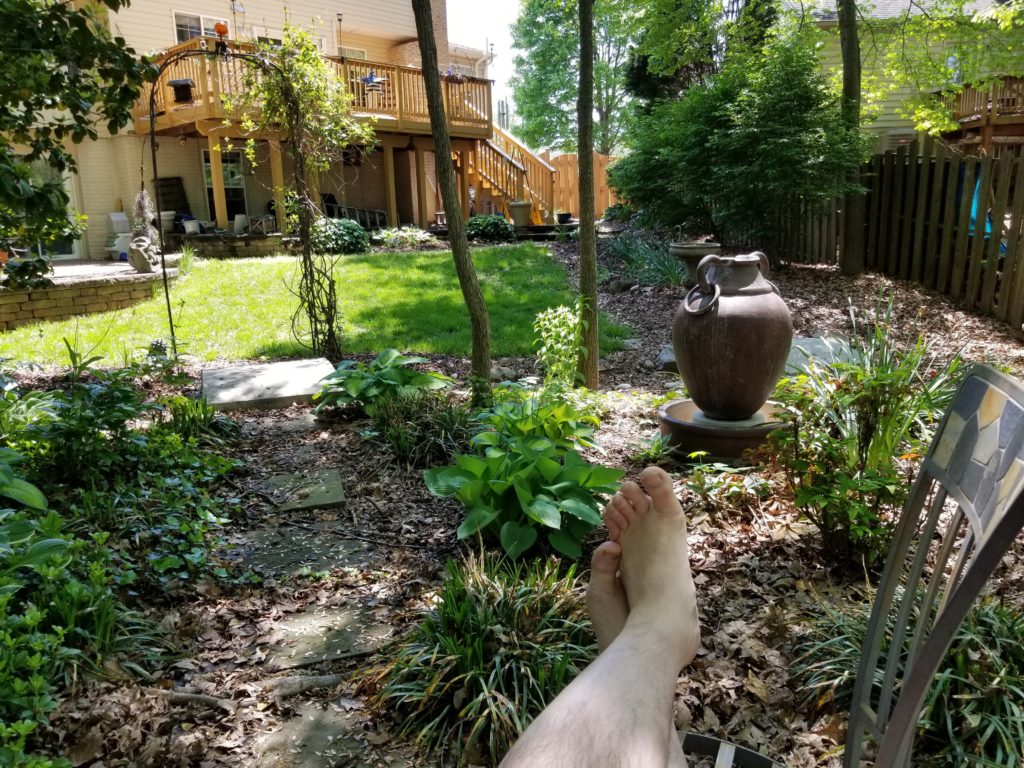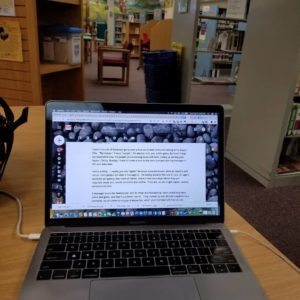How do we do our daily work? Recently Warren Ellis has been urging people to examine and share details of their practice. It’s a good idea in an age of shifting technologies and labor transformation.
Here I’ll describe the tools I use as a professional futurist and why I rely on them. Consider this a kind of techno-auto-ethnography, pinned in a given place and time.
tl:dr – I mostly work from my laptop, somewhat nomadically. Other hardware and analog items come in, along with plenty of software and digital documents.
SPACE: When I’m at home I mostly work from the home office. Right now that means a big desk stacked with papers, books, and hardware. I work on one laptop, primarily (MacBook Pro); two other laptops (PC, Mac) are there for backups. Leaning against the desk is a whiteboard for upcoming gigs. Easily 98% of my home office attention is on the laptop.
Soon we will get my books back from storage – remember, we just moved house cross-country – so I can line the office with bookshelves. That’s important to me for reference, inspiration, and general mood. And for the cats:

Hunter is patient.
I do not have a special location for video, other than my desk.
I can also move around the house and yard, depending on weather, hauling my laptop around.

I’m still shocked at being able to do this in April.
I typically work with audio playing, usually music. I can listen to podcasts (my playlist update is coming soon!) when doing tasks requiring lower cognitive levels, like dealing with basic emails or paperwork. Otherwise, I pick out musical types depending on the work, my mood, and time of day. Nearly all of it comes from YouTube, with some Bandcamp and WFMU supplements. There’s a stirring, sometimes martial playlist for when I’m tired or have to deal for forbidding amounts of email; various metal playlists for writing; ambient, space, and black metal to urge me into more contemplative moods. I alternate these with various classical music performances, depending on the task and my whims.

Working in a public library.
When I travel – which is often, 1-4x/month, mostly in the US, with some global destinations, plus my regular commute into DC for Georgetown or meetings – I improvise a physical workspace. I prefer to use my laptop over my phone for work (thick fingers, plus I like to work between multiple tabs and apps), so hook into WiFi and power outlets as available. Some DC Metro stations have WiFi, and airport WiFi can be ok, depending, so in those happy situations I’ll whip out the laptop and get working, sitting among the other travelers. If those services are not available, I’ll either write and read on the laptop offline, or turn to my Android phone. Typically I work without music or podcasts when traveling, because I want to be able to hear announcements and environmental changes, although I put in an earbud for podcast listening when in venues that are familiar (our immediate neighborhood), stable (walking across DC), or depressing (airports).
With my laptop I carry supplies in the Empire Builder bag: power cord, a disturbingly large box of adapters and dongles, a microfiber screen cleaner, earbuds, an ethernet cable, backup power, and several USB drives.
I also have my smartphone with me at all times. Its use depends on network access, which is now quite good. Being away from Vermont has really improved my ability to get on American cell towers. The only downtimes I experience occur on some DC Metro lines; elsewhere, I’m offline mostly on planes or in certain rural areas. Otherwise, I’m rapidly getting used to always-on cell service, tapping apps of all kinds: Google Maps for wayfinding, local rail app for tickets and schedules, Uber to get around, web browser for on-demand research, etc. And Kindle for reading. This is where I use augmented reality (AR), primarily in low-fi applications, like the aforementioned Google Maps.
Backups: Google and AT&T back up my phone. Laptop content is spread through various cloud services. There’s also a portable hard drive which I need to update.
Communication Things have changed since we moved this winter. For one, I can actually use my cell phone (remember how bad that situation was in Vermont), so I’m making more voice calls that way (which is now a sign of advanced age). I’ve also started texting more.
Videoconferencing has become a major communication tool, now that I have excellent bandwidth. I use Zoom, Shindig, Hangout, Skype, and various others about once per day, and that activity is likely to increase.
Some people reach me through Gchat. I have a window open for that constantly.
Production I produce a lot of digital content – i.e., I write and make other media daily: writing, images, audio, video. Some of that occurs and remains within a single venue, such as email (direct or via MailChimp), Patreon, QuickTime, PowerPoint, Audacity, Shindig, YouTube, Excel, or Word. Some move across multiple platforms for logistical reasons, as when I work with an editor in publishing a column, and we use email, Word, Google Docs, and, ultimately, either print, web, or both as publication destination. Photos start in my phone and may end up on Flickr, Facebook, Instagram, or shared with individuals.
Text: nowadays it’s mostly Word for me. I’ve experimented with some alternatives, and their benefits haven’t seemed worth the time needed to learn and migrate.
Blogging is different. For that, I set up release sequences. First, I compose entirely in WordPress, unless I’m going to be on a plane and off WiFi for a while, in which case I write in Word or TextEdit, for later copying over. Some posts take days to develop; I usually have a stack in draft. (When I set up a book club reading, I create a Monday morning book club prototype post, then copy it for each week. That’s the skeleton for each post.) When I’m satisfied and publish a post, I manually work it across social media, adjusting for each platform. I copy the title and URL pair, which I take to LinkedIn, Twitter, and Mastodon, adding appropriate hashtags for each, @-ing at relevant Twitter users, and picking out content warnings for Masto. I copy the URL alone to Medium for story import, then manually edit the results before posting, correcting quotation issues, reloading broken images, etc. – although their import function has been iffy of late. Then I translate for Facebook. FB resents links, in my experience, so now I write a short summary of the blog post, then add the URL in a comment.
I used to have this all done automatically, but the results weren’t satisfying. Facebook would hide its post, hashtags on one wouldn’t work on others, and individual shout-outs need identification and formatting separately for each platform. All too often my cross-platform transmissions appeared out of context. What I do now takes more time, but is more effective.
For the Web in general, I rely on the Google Chrome browser. Typically I have open [mumble mumble] tabs. I also turn to FireFox and Safari when I need different browsers – i.e., for testing different functions or evading paywalls.
Audio and video: I record video and audio either from my laptop, which suffices for most needs, or a little camera upon a tripod, or from my phoneSoftware: primarily Audacity and iMovie, which meet nearly all of my needs. I like to noodle around a bit in Garageband (and why isn’t there a Windows version by now?). I haven’t used FinalCut Pro for years, as it’s overkill for my typical project.
Consumption Most of what I learn I learn through reading. I hoover up text through all kinds of mechanisms. RSS is important, although I’ve been whittling down my subscriptions in Inoreader. I read ebooks (mostly through Kindle apps) and print books (often from local and academic libraries, increasingly with my reading glasses).
Social media plays a key role in my work, as I’ve written before. The leading venue is Twitter, which I experience wholly through Tweetdeck. I hit Facebook, LinkedIn, Mastodon, etc. most often through web browsers.
Beyond reading texts, I listen and watch stuff. Most of my listening comes through podcasts in Stitcher, usually on the phone. I’m not that happy with Stitcher, but it’s the least bad podcatcher I’ve found. I watch videos on YouTube, Netflix (streaming *and* DVD), Amazon, and now Criterion’s streaming service.
I try to focus my research on open materials, content that any reader can access with a web browser, but more and more content is heading behind paywalls, even as the open access revolution proceeds. Journalism is increasingly hidden away, while a substantial chunk of scholarship remains in proprietary silos. My recent affiliation with Georgetown University generously gives me access to the full range of human research, plus some parts of journalism, and I realize not everyone has this advantage. One question awaits my decision: how many services to subscribe to? The Financial Times, for my economics research? The New York Times, as the “newspaper of record,” or the Washington Post, since it covers my new neighborhood? Apple’s new News service, for a package? Or do I resist these and remain in the open?
Games: most of my gaming is on laptops now, always through Steam. (Currently learning Stellaris and Crusader Kings 2) The cross-country move kept me away from the XBox, so I’ve fallen out of that habit. No cell phone games have won my heart lately.
Teaching: Over the past year my students have insisted on using Canvas, so I’ve spent a good amount of time learning and teaching through it. Some classes have occurred when I’ve been on the road, from New York to Melbourne, and those I taught through Zoom. I keep notes in Word. No PowerPoint for me; when I deliver mini-lectures I do so mostly from memory, with a few outline notes in Word. Visuals are web pages I bring up, links preloaded in browser.

Not currently in use by me, but under consideration: telepresence robots, because nearly nobody is hosting them. I’m not using much VR now, beyond researching the topic, because the games I play (strategy) don’t have a VR presence. Not owning HoloLens or Magic Leap as a consumer, I’m not using them outside the university class and library. Slack: to be honest, I haven’t gotten into it. I keep trying, but the bug hasn’t bitten me. Blockchain: I’ve poked at a few projects, but haven’t had the time needed to truly immerse. Prezi: I love making and presenting in it, but it reliably irks audiences in non-productive ways. Like making some nauseous. Github: I haven’t found a good way to use it yet. Everything I’d like to share there is paywalled or otherwise private, and works fine in Google Drive.
My family has been using Alexa for a year. My wife and children will ask her for the time, the weather, for music, to change lights, to grow a grocery list, and for playing podcasts. I haven’t done much with the Amazon speaker-AI yet, mostly because I want finer control over music and podcasts, but hope to explore other functions as my office gets set up.
I love physical, analog notebooks, but can’t use them for long. It’s partly because I’m not in the habit, partly because my handwriting is vile, and also because I depend on so many digital functions – Googling, getting URLs, sharing thoughts. One exception: I have gotten back into the habit of recording my dreams when I wake up in a red notebook.
On reflection, all of this practice looks fairly ordinary and conservative for a futurist, I think. Conventional devices, widely used software. Google Apps, Microsoft Office. I should be testing out more novel tools. But I don’t have the perspective on my own practice. What do you think? What am I missing?





It is so beautiful to me that you have such strong hope in your self-created authentic existence.
Thank you, Ellen. I’m passionate about what I do.
It appears that all you are missing is dancing, eating lovely food, glasses of wine, and sleep!
Margit, that’s a splendid thought. I don’t get nearly enough of those.
(And I can’t drink wine any longer, too.)
Is your red notebook the Bryan Alexander equivalent of Jung’s Red Book?
I actually wondered about that when I started doing it.
Now to add some alchemy.
Pingback: Daily Practice – Tools of the Trade – HigherEdJournal